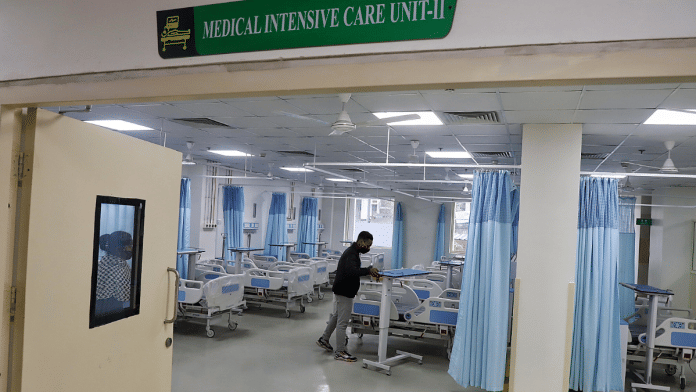Thank you dear subscribers, we are overwhelmed with your response.
Your Turn is a unique section from ThePrint featuring points of view from its subscribers. If you are a subscriber, have a point of view, please send it to us. If not, do subscribe here: https://theprint.in/subscribe/
The death of 13-year-old Rupesh Ganesh Thapad, an Adivasi boy from the Vasai Virar Municipal area, on the morning of October 7, 2025, was no sudden catastrophe. It was a preventable agony, drawn out over hours of institutional indifference and profit-driven refusals. This tragic sequence exposes the fractured healthcare system that fails India’s uninsured urban poor, where a child’s life is weighed against administrative hurdles and financial risks.
Rupesh’s ordeal began in the predawn hours. At 4:00 AM, he started vomiting severely, soon bleeding from his nose and mouth. His family, desperate for help, called on a local doctor at 5:30 AM, only to find him not available. With his condition deteriorating rapidly, they rushed him to the nearby Municipal Hospital at Kharodi by 7:30 AM. This public facility, meant to serve as a safety net for all citizens, faltered immediately. Medics assessed his dire state visually and directed the family to a nearby Charitable Trust’s Hospital, effectively passing the buck.
By 8:30 AM, the “golden hour” for intervention had slipped away. At the Charitable Trust’s Hospital, admission was denied—likely due to a lack of ICU beds. Instead, they referred the family to a Paediatric Hospital just 400 meters away. The family scrambled to arrange an ambulance with oxygen support, costing Rs 1,000, and transported Rupesh there. But upon arrival, they faced a stunning rejection: the hospital was undergoing an audit and could not admit new patients. Bureaucracy trumped urgency, leaving a bleeding child without care.
What followed was a harrowing, exhausting journey across the city, both physically and financially. Accompanied by a helpful acquaintance—an RMO from the Kharodi Health Centre—the family transferred Rupesh to a larger ambulance. They initially headed to a Christian Charitable Hospital in Vasai, but time was running out. Diverting to a Private Hospital in Nalasopara around 9:30 AM, they hoped for relief. After review, this facility too declared itself unable to treat him. It costed another Rs 3,000 for the next ambulance ride.
The final leg of this desperate odyssey brought them to a larger Charitable Hospital in Vasai by 10:30 AM. Here, the rejection was crushing: the institution deemed the case “not recoverable.” In a last-ditch effort, the family decided to try one more municipal hospital. Tragically, Rupesh vomited one final time and died en route in the ambulance.
Rupesh’s story is a damning indictment of how human life is valued in urban India, particularly for the poor. Imagine if he had health insurance worth Rs 5 lakh, or parents who could front a deposit of a couple of lakhs. Would the outcome have been different? The initial refusal by the Municipal Hospital set a grim pattern: public institutions, under-resourced or unwilling to handle critical cases, shunt patients to the private sector. The subsequent denials by four private hospitals—citing no ICU, an audit, insufficient facilities, or irrecoverability—reveal a bias toward low-risk, paying patients. Rather than stabilizing the boy, hospitals prioritized avoiding liability, violating the essence of the Hippocratic Oath.
The financial toll compounded the cruelty. The family spent Rs 6,000 on ambulances that served as shuttles for rejection, while state-run 108 emergency services went unanswered. Even in death, exploitation persisted: a BAMS doctor charged Rs 2,500 for the death certificate, a bureaucratic formality that the grieving mother will repay over the next 12-18 months.
Vasai Virar’s Municipal Corporation, established over 15 years ago, exemplifies this hollow welfare state. It lacks a centralized medical hub, offering only unfulfilled promises. Elites escape to Mumbai’s luxury hospitals, while the underclass is left scrambling. Political gestures abound—multiple groundbreaking ceremonies for a multispecialty hospital without land allocation, a ceremonial cheque from a former Chief Minister that vanished into thin air. Corruption lurks beneath: the city’s first Municipal Commissioner was arrested by the Enforcement Directorate for allegedly amassing a Rs 167 crore empire, though courts later found evidence insufficient.
This is the “welfare state” promised by India’s Constitution, forged by “We, the People.” For Rupesh, it meant death by deferral—a system where compassionate care is a privilege, not a right. His passing demands urgent reckoning: streamline referrals, bolster frontline funding, and humanize healthcare. Without reform, more children will pay the ultimate price in this tiered valuation of life.
These pieces are being published as they have been received – they have not been edited/fact-checked by ThePrint.



This is the reality of so called 4th largest economy in the world. This is an unfortunate fact of bureaucracy of India. This is real value of human life of people under/around poverty line. And there is no hope. People are denied/ refused openly. People die on roads for no fault of theirs. Who cares and why would even someone bother? You could be considered only if you have good political connections or lot of money in your pocket.
Well done Rajesh Naik.. by bringing this fact on this forum